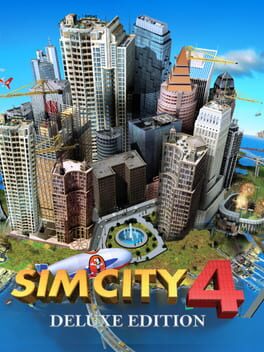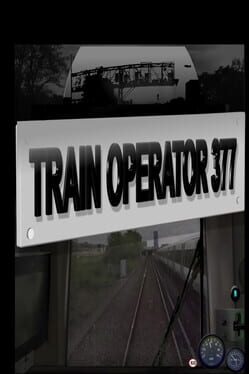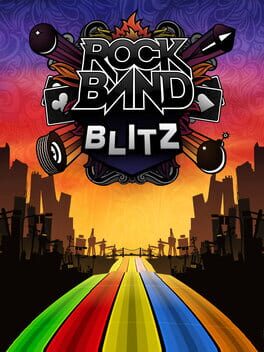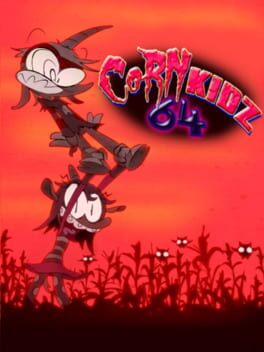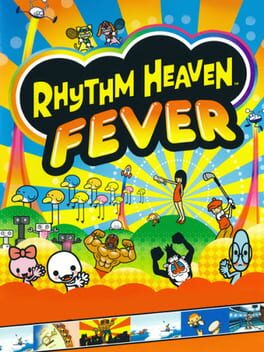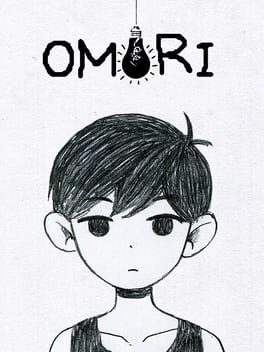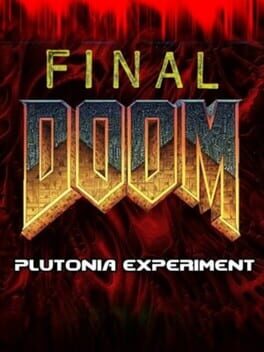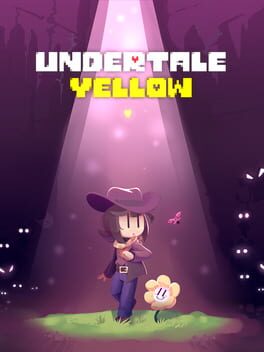eldomtom2
2023
2012
2023
Corn Kidz is an absolute gem. The movement is just so good. Its pastiche of N64 platformers (especially Rare's) is absolutely pitch-perfect. The levels are excellently designed, taking full advantage of the movement, and filled with wonderful moments when abilities are unlocked - discovering the true meaning of Wolloh's Hollow is brilliant. The writing is hilarious - if you look at Bogo's much earlier work (everything on his website predates 2010) he's clearly matured a lot as a writer, dropping his old obsession with randomness and violence. The music is great. The animation is packed with lovely details, especially the excellent squash-and-stretch. Alexis and Seve are my adorable goat babies and I would die for them.
I only have a few very minor issues. For one, the identity of the Zombie Grunthers isn't immediately obvious, which is a shame because when I saw their name in the credits it was an "a-ha!" moment and I realised how you were supposed to figure out how to defeat them, which I only figured out by accident. Also there should be multiple save files, ideally with a cool animated menu to choose between them.
Finally, the biggest issue is that there isn't more of it. That's not to say it isn't worth it - you will get far beyond £5.89 worth of fun out of it - but it would be a massive shame if these excellent characters and this excellent gameplay weren't used in more content.
tl;dr buy corn kidz 64 now, i want a sequel
Also, you could absolutely make a reading of everything to do with Wolloh's Hollow as a right-wing statement about immigration, as was done with the Angry Birds Movie. I'm not saying Bogosoft intended it. But you could do it.
I only have a few very minor issues. For one, the identity of the Zombie Grunthers isn't immediately obvious, which is a shame because when I saw their name in the credits it was an "a-ha!" moment and I realised how you were supposed to figure out how to defeat them, which I only figured out by accident. Also there should be multiple save files, ideally with a cool animated menu to choose between them.
Finally, the biggest issue is that there isn't more of it. That's not to say it isn't worth it - you will get far beyond £5.89 worth of fun out of it - but it would be a massive shame if these excellent characters and this excellent gameplay weren't used in more content.
tl;dr buy corn kidz 64 now, i want a sequel
Also, you could absolutely make a reading of everything to do with Wolloh's Hollow as a right-wing statement about immigration, as was done with the Angry Birds Movie. I'm not saying Bogosoft intended it. But you could do it.
2022
Why the actual fuck did they decide that of all the games Guitar Hero 3 was the engine and hit detection to emulate. Oh yeah, because if they didn't all those stupid kaizo charts would be literally impossible.
And that's not going into all the missing Rock Band features, or how the high score system lacks the most basic features...
I haven't tried YARG yet, hopefully it's better.
And that's not going into all the missing Rock Band features, or how the high score system lacks the most basic features...
I haven't tried YARG yet, hopefully it's better.
There is a common myth that Subspace Emissary is good. This is false. Subspace Emissary is bad.
To begin with, the gameplay is bad. Smash is not a platformer. But the games' singleplayer modes have kept trying to force it into being one, even though every character is floaty and awkward to control in a regular platforming environment. But even if the characters controlled well, the levels would still be terrible - they are dull, dull, dull, with a love for gimmicks everyone hates like auto-scrolling. And then there are the bosses - bosses are universally unfun and terrible in every Smash game, and Brawl is no exception. Unfortunately they're one of the few times where Subspace actually lives up to its crossover ideals.
And the integration of graphics and gameplay is terrible as well. Making everything realistic was probably a mistake. But if you're going to make everything realistic, then actually bother to integrate the gameplay elements into the environment instead of having a bunch of floating platforms and glowing doors connected to nothing (especially egregious when e.g. the stage gimmick is switching between two different versions of the level, distinguished by nothing by minor color scheme changes). And if you're not going to do that, then at least try to make sure the cutscenes and gameplay environment match instead of looking completely different.
And onto the story and setting, this is perhaps Subspace's biggest failure. Who was asking for this? Who didn't want to fight classic enemies in iconic environments, but instead fight the "Subspace Army", a group of dull enemies with no consistency in design or style, in such thrilling environments as "the Forest" or "the Plain"? Occasionally it does strike upon an interesting idea like the Ruined Zoo, but without any context it's empty. People often cite the cutscenes as a high point, and some are indeed good. But for every cutscene that has a neat character moment, there's another one where the characters nod at each other and run off into the character select screen transition.
I'll end this review by plagiarising Tim Brayton's Attack of the Clones review:
Anyway, who comes along, riding to the rescue, but our old friend Nobuo Uematsu? The theme to Brawl is better than miraculous - it might actually be the best of all the Smash games. It is powerful and resonant enough to make terrible scenes look better and good scenes look astonishing - the game's final scene of the characters facing the sunset as the main theme plays in full is so exciting and transporting that it's actually enough to send you on your way convinced you just played something dramatic and intense and wholly enthralling.
The rest of the game is better, but then I remember that all the good DK songs are on fucking Rumble Falls and I'm disinclined to be positive towards it.
To begin with, the gameplay is bad. Smash is not a platformer. But the games' singleplayer modes have kept trying to force it into being one, even though every character is floaty and awkward to control in a regular platforming environment. But even if the characters controlled well, the levels would still be terrible - they are dull, dull, dull, with a love for gimmicks everyone hates like auto-scrolling. And then there are the bosses - bosses are universally unfun and terrible in every Smash game, and Brawl is no exception. Unfortunately they're one of the few times where Subspace actually lives up to its crossover ideals.
And the integration of graphics and gameplay is terrible as well. Making everything realistic was probably a mistake. But if you're going to make everything realistic, then actually bother to integrate the gameplay elements into the environment instead of having a bunch of floating platforms and glowing doors connected to nothing (especially egregious when e.g. the stage gimmick is switching between two different versions of the level, distinguished by nothing by minor color scheme changes). And if you're not going to do that, then at least try to make sure the cutscenes and gameplay environment match instead of looking completely different.
And onto the story and setting, this is perhaps Subspace's biggest failure. Who was asking for this? Who didn't want to fight classic enemies in iconic environments, but instead fight the "Subspace Army", a group of dull enemies with no consistency in design or style, in such thrilling environments as "the Forest" or "the Plain"? Occasionally it does strike upon an interesting idea like the Ruined Zoo, but without any context it's empty. People often cite the cutscenes as a high point, and some are indeed good. But for every cutscene that has a neat character moment, there's another one where the characters nod at each other and run off into the character select screen transition.
I'll end this review by plagiarising Tim Brayton's Attack of the Clones review:
Anyway, who comes along, riding to the rescue, but our old friend Nobuo Uematsu? The theme to Brawl is better than miraculous - it might actually be the best of all the Smash games. It is powerful and resonant enough to make terrible scenes look better and good scenes look astonishing - the game's final scene of the characters facing the sunset as the main theme plays in full is so exciting and transporting that it's actually enough to send you on your way convinced you just played something dramatic and intense and wholly enthralling.
The rest of the game is better, but then I remember that all the good DK songs are on fucking Rumble Falls and I'm disinclined to be positive towards it.
2011
2020
This review contains spoilers
(I originally wrote this review for r/patientgamers in July 2022, after I'd finished the game for the first time. Since then I have 100%d the game. I still agree with most of what I say in the review, though I'd like to add that I have become very fond of the characters. I also take a much less negative view of the game's ending nowadays.)
I recently finished Omori. I'd seen it getting a fair bit of buzz and seeing as it was discounted during the Steam summer sale I thought why not. Once I'd finished the game, I found myself to have highly ambivalent thoughts on it, so I wrote this in the hope of perhaps gaining some insight into my thoughts on it.
Obviously talking about Omori primarily means talking about its story, so let's talk about its non-story elements first.
People often talk about the graphics of Omori being good, but that's only really during the battles. The overworld is utterly generic pixel art; I don't object to it, but neither does it go beyond providing adequate representations of the characters and scenery.
The designs of the characters and locations themselves are perfectly fine and appealing; I don't have much to say on the topic except that I found the bunnies drawn as simple blobs cute.
Gameplay-wise, Omori is nothing special. It doesn't have grinding or too-frequent battles, so I can tolerate its JRPG gameplay, but it doesn't elevate its JRPG mechanics into something I actually find enjoyable like something like Deltarune did.
Omori's music I would say is good but not great. It's not an outstanding masterpiece, and there are quite a few forgettable tracks, but it definitely rises above just getting the job done.
I'm moving onto the story now, so obviously spoiler warning.
First off, I should say that I was spoiled on the central twist of the game (that Sunny killed Mari, and he and Basil pretend it was a suicide). I would not have picked it up otherwise; I despise games where figuring out "what it meant" is essential to understanding the plot, and knowing it all got explained in the end made all the symbolism tolerable. I did not, and do not, feel like being spoiled is the cause of my ambivalence towards the game. I knew the source of Sunny's trauma; I did not know how he would resolve it or what the consequences of that resolution would be.
I did, however, read about the alternate routes etc. after I had beaten the game.
My first major problem with Omori's story is its tonal whiplash - people usually talk about this in a joking way, but I found it a serious problem. The Headspace segments, the horror segments, and the real world segments all feel like they came from completely different games and were stapled together. This is hard to fully articulate, but I definitely felt it. Perhaps a good example of this is just how grounded the real-world segments are - you don't even get to beat up random animals like Earthbound would make you do. That's not a criticism of the real world segments - I like how grounded they are - but it makes the shifts to the other parts more jarring.
Moving on to my criticisms of the segments themselves, Headspace really doesn't justify its existence. Its plot completely fizzles out after Sweetheart's Castle, as events gradually become more and more disconnected and meaningless. I get that's the point, but it raises the question of why so much time was spent in Headspace to begin with. It isn't linked closely enough to Sunny's real life for it to provie insights on him. Perhaps even a larger problem is that so much time is spent on the Headspace friends, and there's so much emphasis on your bond with them growing. What's the point if it's all an illusion?
The final segment in Sunny's mind, where the truth is revealed, the violin repaired, and Omori confronted, works a lot better, because it's much more directly linked to Sunny's real experiences.
Headspace does have some good jokes etc., but they're good in isolation. They don't add to the overall game.
The horror segments (I am mainly speaking of Black Space) justify their existence slightly more, but ultimately don't add much. They're primarily just a bunch of spooky imagery without much connection to the actual plot - the bits that actually do, like the sequence where the truth is revealed, feel firmly separated off from the more sandbox Black Space segments. It feels like they were included out of obligation as a game influenced by Yume Nikki rather than because they actually benefitted the game.
Finally there are the real world segments, which are generally Omori's biggest success. Faraway Town is packed with fun and interesting stuff and really wants you to stop and smell the flowers. But I ended up not taking that much time to stop and smell the flowers; I wanted to see where the story went next. The problem is there is a massive amount of sidequests in the game, and especially in the real world segments doing these is important for the story and character arcs. If you don't do them you'll be missing a lot of character moments for the our main characters, including big stuff like learning their initial reactions to Mari's death. The game is littered with unnmarked points of no return, so doing them would require a full second playthrough. I'm not asking to be railroaded down every sidequest, but making some important stuff like laying flowers on Mari's grave mandatory I think would make sense, as well as perhaps providing hints about points of no return and perhaps encouraging the player a bit more to go out and find sidequests.
Moving on to the actual story as a whole, it suffers from the massive problem - probably my biggest problem with the game - in that it leaves the aftermath of Sunny telling the truth completely up to player interpretation.
Now you can say that the game's message is that Sunny telling the truth is the right thing to do regardless of his friends' reactions, but if that's the case the dream versions of his friends telling him to do the right thing in the ending sequence should probably have been cut. Also, so much time is spent on Aubrey, Hero, and Kel to the point where it really feels like their stories deserve closure as well.
Making matters worse, the key scene of Something leaving Sunny and Basil is locked behind the fairly obtuse task of watering Headspace Basil's flowers every day. Without that, Basil's arc is left utterly unfinished.
On an unrelated note, I get the feeling that the story changed a lot during development. With how much White Space is set up as representing the hikkiomori lifestyle in the very early Omori stuff, I get the feeling that it in the final game is a leftover from that, because in the final game there isn't much differentation between White Space and Headspace. I wonder if the very first concept even featured the real world. There's also stuff like "the mysterious part of town" in the early map of Faraway Town that Omocat showed in the Basil's birthday livestream, or how the original idea was that the good and bad endings wouldn't be decided based on whether or not you chose to continue after the fake game over screen, but whether you followed the Headspace friends or the Stranger in the hospital - which makes sense, because there the final game presents what appears to be a choice but actually isn't. I suspect that part of the disjointedness I feel comes from constant rewrites that tried to keep as much existing work as possible.
But for all my criticisms I still enjoyed many parts of Omori. Praising something is more difficult than criticising something, especially in this case where a big part of my enjoyment came from just hanging around with well-written and fleshed-out characters who felt extremely believable. But I did really enjoy my time spent with Kel, Hero, and Aubrey. I just wish the game didn't keep interrupting it, and that it prodded me to spend more time with them.
To finish off, I would like to say that I have trouble articulating my thoughts, and would be very happy if this provoked discussion - if nothing else, answering questions would probably help me work out my thoughts on the game.
also they were cowards for not using funculi funcula for the pizza delivery minigame
I recently finished Omori. I'd seen it getting a fair bit of buzz and seeing as it was discounted during the Steam summer sale I thought why not. Once I'd finished the game, I found myself to have highly ambivalent thoughts on it, so I wrote this in the hope of perhaps gaining some insight into my thoughts on it.
Obviously talking about Omori primarily means talking about its story, so let's talk about its non-story elements first.
People often talk about the graphics of Omori being good, but that's only really during the battles. The overworld is utterly generic pixel art; I don't object to it, but neither does it go beyond providing adequate representations of the characters and scenery.
The designs of the characters and locations themselves are perfectly fine and appealing; I don't have much to say on the topic except that I found the bunnies drawn as simple blobs cute.
Gameplay-wise, Omori is nothing special. It doesn't have grinding or too-frequent battles, so I can tolerate its JRPG gameplay, but it doesn't elevate its JRPG mechanics into something I actually find enjoyable like something like Deltarune did.
Omori's music I would say is good but not great. It's not an outstanding masterpiece, and there are quite a few forgettable tracks, but it definitely rises above just getting the job done.
I'm moving onto the story now, so obviously spoiler warning.
First off, I should say that I was spoiled on the central twist of the game (that Sunny killed Mari, and he and Basil pretend it was a suicide). I would not have picked it up otherwise; I despise games where figuring out "what it meant" is essential to understanding the plot, and knowing it all got explained in the end made all the symbolism tolerable. I did not, and do not, feel like being spoiled is the cause of my ambivalence towards the game. I knew the source of Sunny's trauma; I did not know how he would resolve it or what the consequences of that resolution would be.
I did, however, read about the alternate routes etc. after I had beaten the game.
My first major problem with Omori's story is its tonal whiplash - people usually talk about this in a joking way, but I found it a serious problem. The Headspace segments, the horror segments, and the real world segments all feel like they came from completely different games and were stapled together. This is hard to fully articulate, but I definitely felt it. Perhaps a good example of this is just how grounded the real-world segments are - you don't even get to beat up random animals like Earthbound would make you do. That's not a criticism of the real world segments - I like how grounded they are - but it makes the shifts to the other parts more jarring.
Moving on to my criticisms of the segments themselves, Headspace really doesn't justify its existence. Its plot completely fizzles out after Sweetheart's Castle, as events gradually become more and more disconnected and meaningless. I get that's the point, but it raises the question of why so much time was spent in Headspace to begin with. It isn't linked closely enough to Sunny's real life for it to provie insights on him. Perhaps even a larger problem is that so much time is spent on the Headspace friends, and there's so much emphasis on your bond with them growing. What's the point if it's all an illusion?
The final segment in Sunny's mind, where the truth is revealed, the violin repaired, and Omori confronted, works a lot better, because it's much more directly linked to Sunny's real experiences.
Headspace does have some good jokes etc., but they're good in isolation. They don't add to the overall game.
The horror segments (I am mainly speaking of Black Space) justify their existence slightly more, but ultimately don't add much. They're primarily just a bunch of spooky imagery without much connection to the actual plot - the bits that actually do, like the sequence where the truth is revealed, feel firmly separated off from the more sandbox Black Space segments. It feels like they were included out of obligation as a game influenced by Yume Nikki rather than because they actually benefitted the game.
Finally there are the real world segments, which are generally Omori's biggest success. Faraway Town is packed with fun and interesting stuff and really wants you to stop and smell the flowers. But I ended up not taking that much time to stop and smell the flowers; I wanted to see where the story went next. The problem is there is a massive amount of sidequests in the game, and especially in the real world segments doing these is important for the story and character arcs. If you don't do them you'll be missing a lot of character moments for the our main characters, including big stuff like learning their initial reactions to Mari's death. The game is littered with unnmarked points of no return, so doing them would require a full second playthrough. I'm not asking to be railroaded down every sidequest, but making some important stuff like laying flowers on Mari's grave mandatory I think would make sense, as well as perhaps providing hints about points of no return and perhaps encouraging the player a bit more to go out and find sidequests.
Moving on to the actual story as a whole, it suffers from the massive problem - probably my biggest problem with the game - in that it leaves the aftermath of Sunny telling the truth completely up to player interpretation.
Now you can say that the game's message is that Sunny telling the truth is the right thing to do regardless of his friends' reactions, but if that's the case the dream versions of his friends telling him to do the right thing in the ending sequence should probably have been cut. Also, so much time is spent on Aubrey, Hero, and Kel to the point where it really feels like their stories deserve closure as well.
Making matters worse, the key scene of Something leaving Sunny and Basil is locked behind the fairly obtuse task of watering Headspace Basil's flowers every day. Without that, Basil's arc is left utterly unfinished.
On an unrelated note, I get the feeling that the story changed a lot during development. With how much White Space is set up as representing the hikkiomori lifestyle in the very early Omori stuff, I get the feeling that it in the final game is a leftover from that, because in the final game there isn't much differentation between White Space and Headspace. I wonder if the very first concept even featured the real world. There's also stuff like "the mysterious part of town" in the early map of Faraway Town that Omocat showed in the Basil's birthday livestream, or how the original idea was that the good and bad endings wouldn't be decided based on whether or not you chose to continue after the fake game over screen, but whether you followed the Headspace friends or the Stranger in the hospital - which makes sense, because there the final game presents what appears to be a choice but actually isn't. I suspect that part of the disjointedness I feel comes from constant rewrites that tried to keep as much existing work as possible.
But for all my criticisms I still enjoyed many parts of Omori. Praising something is more difficult than criticising something, especially in this case where a big part of my enjoyment came from just hanging around with well-written and fleshed-out characters who felt extremely believable. But I did really enjoy my time spent with Kel, Hero, and Aubrey. I just wish the game didn't keep interrupting it, and that it prodded me to spend more time with them.
To finish off, I would like to say that I have trouble articulating my thoughts, and would be very happy if this provoked discussion - if nothing else, answering questions would probably help me work out my thoughts on the game.
also they were cowards for not using funculi funcula for the pizza delivery minigame
Plutonia is a masterclass in FPS level design. Every encounter is brutally difficult but never feels unfair.
The only flaw it is has is that it's often unclear which pits are inescapable or which floors are damaging. Oh, and MAP30 sucks as all Icon of Sin fights do. Other than that it's a masterpiece.
The only flaw it is has is that it's often unclear which pits are inescapable or which floors are damaging. Oh, and MAP30 sucks as all Icon of Sin fights do. Other than that it's a masterpiece.
2023
This review contains spoilers
So much of Undertale Yellow is fantastic. It's polished to a mirror sheen, the soundtrack is gorgeous, and the gameplay is excellent. It avoids falling into any of the typical Undertale fan content traps (in particular Sans is not even mentioned once, which I am deeply thankful for, nor is there any hint of Gaster). It's such a shame that it stumbles on the story front. I don't want to go too into depth on the story, but I do want to talk about why its worst part - the pacifist ending - doesn't work.
The big emotional and gameplay climax, the Ceroba boss fight (which ignoring the plot really is amazing and is the actually challenging final fight Undertale's pacifist route deserves), is disconnected from the actual ending. Clover sacrifices themselves for reasons that are mostly unrelated to Ceroba and Kanako's story. The Kanako plotline receives no resolution, just a handwavey line from Martlet that she'll look into it - which doesn't even work as a weak resolution since Undertale prevents the truth being known until the events of that game. Compare this with Undertale. The story revolves around the Dreemurr family (including Chara), so the final boss is Asriel, and the scenes during and after that boss fight resolve that plotline. The Ketsukanes are clearly filling the same narrative role as the Dreemurrs did in Undertale, but their plotline doesn't receive resolution.
And that's not even getting into the fact that it feels completely implausible that the characters would just let Clover commit suicide...
That said for the rest of the game the story does at least hold together, and in individual scenes the writing is often very good indeed.
The big emotional and gameplay climax, the Ceroba boss fight (which ignoring the plot really is amazing and is the actually challenging final fight Undertale's pacifist route deserves), is disconnected from the actual ending. Clover sacrifices themselves for reasons that are mostly unrelated to Ceroba and Kanako's story. The Kanako plotline receives no resolution, just a handwavey line from Martlet that she'll look into it - which doesn't even work as a weak resolution since Undertale prevents the truth being known until the events of that game. Compare this with Undertale. The story revolves around the Dreemurr family (including Chara), so the final boss is Asriel, and the scenes during and after that boss fight resolve that plotline. The Ketsukanes are clearly filling the same narrative role as the Dreemurrs did in Undertale, but their plotline doesn't receive resolution.
And that's not even getting into the fact that it feels completely implausible that the characters would just let Clover commit suicide...
That said for the rest of the game the story does at least hold together, and in individual scenes the writing is often very good indeed.
It's a good piece of interactive fiction. But as a game it's severely lacking, and it's clear from pre-release comments that the devs had much grander ideas for the RPG systems than they ended up managing to execute. This ultimately quite heavily harms both the fun and the immersion - no matter what sort of a cop you play Harry as, he'll always be a serial clothes thief who changes right in front of a soon-to-be-grieving widow so he can get +1 to his empathy skill.
Also the fanbase is fully of terminally online communists which miss the point of the game.
Also the fanbase is fully of terminally online communists which miss the point of the game.

